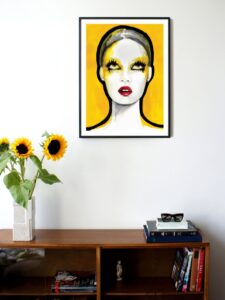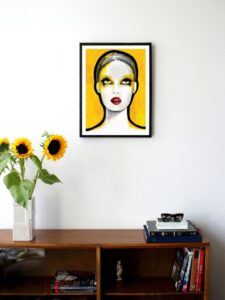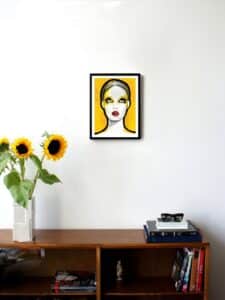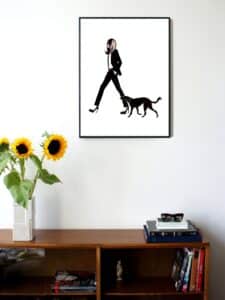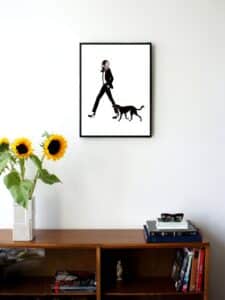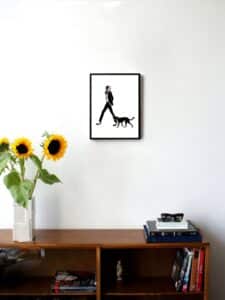FAQ
Limited edition giclée prints
Our prints are high-quality, limited edition giclée prints of original fashion illustrations by Sjoukje Bierma.
They are printed by Ruijgrok Piezografie of Amsterdam using Canon Lucia professional-grade pigment ink on museum-quality Hahnemühle 300gsm Platinum Rag paper.
This means that they look stunning and, properly cared for, will continue to do so – literally – for a lifetime. You can read more about giclée printing here. (link to Giclee Printing page) Numbered, signed and authenticated
Each print is uniquely numbered and signed by the artist in pencil. Each print is also titled and signed by the artist on the reverse side.
A signed certificate of authenticity accompanies each print.
Once a series of limited edition prints has been completely issued, no further prints will be issued in this format.
Please note that these prints are sold unframed – images of the framed prints are for demonstration purposes only.
Print sizes
Our prints are issued in specific sizes. These are (width x height):
– 30 x 40cm;
– 45 x 60cm; and
– 60 x 80cm.
Print editions
An edition is the number of prints that will be made of the original illustration, in a particular size.
Once a limited edition has been sold out, then no more prints of that fashion illustration will be made in that size.
Our prints are generally issued in limited editions of 10, 20 or 30, depending on the illustration and the print size. Each print is numbered by Sjoukje (by hand, on the front) , e.g. 1 / 10, 2 / 10, 3 / 10….up to 10 / 10.
Each edition also has a single Artist’s Proof (A/P) print created, which is kept in Sjoukje Bierma’s personal archives.
For example, Yellow Face is issued in 3 formats & editions:
– 60 x 80cm, 10 editions + 1 A/P
– 45 x 60cm, 20 editions + 1 A/P
– 30 x 40cm, 30 editions + 1 A/P
Comparison of the different sizes of prints
Below are some comparable photos of the different sized prints, framed using 1.5 cm wide dark oak (with a 0.5 cm lip around the edge of the print).
Please note that our fashion illustration prints are sold unframed.
60 x 80 cm print | 40 x 65 cm print | 30 x 40 cm print |
Giclée (“g-clay”) printing is a fine art digital printing process known for producing archival quality prints.
The benefits and advantages of giclée printing
Giclée printing is the preferred printing method for many museums, art galleries and photographic galleries because it provides:
– near perfect integrity (i.e. the printed image is identical to the original, perfectly replicating all of the colours, detail and brushwork of the original work), and;
– superior light-fastness and stability (i.e. the colours don’t fade).
The giclée printing process
Images are generated from high resolution digital scans and fine-tuned by hand to the type of substrate or surface on which the image is to be printed, to ensure the closest possible match to the original work.
The giclée printing process itself involves squirting or spraying microscopic dots of pigment-based ink onto various archival-quality substrates including canvas, fine art, and photo-base paper. The French verb “gicler” means “to spray”.
Pigment-based inks – compared to dye-based inks used in lower-cost inkjet printing – have a much longer lifespan and light-fastness.
When used in combination with archival paper, pigment-based inks will not fade over a lifetime (providing, of course, they are kept out of direct sunlight, damp, etc).
Caring for your Sjoukje Bierma giclée print
Giclée prints are renowned for their extreme longevity and for delivering near-perfect integrity to the original work (colours, brush-strokes and textures); this is why they are displayed in the world’s finest museums, art galleries and private art collections.
Correctly cared for, your Sjoukje Bierma Illustrations giclée print should bring pleasure to you and your loved ones for generations.
Please read and follow the care instructions below. If you have any questions, please do not hesitate to contact us using the contact form or by e-mail (info@sjoukjebiermaillustrations.com) and we shall be happy to advise.
General points for handling your giclée print
Giclée prints should be cared for in the same way as an original piece of art.
This means that dirt, dust, moisture, oils, adhesives, solvents, heat, and anything that could scratch, dent or crease the paper should all be avoided when you are handling your print.
We therefore recommend taking your print directly to the framer, in its packaging. However, if you want to unpack your print at home, here are some general handling guidelines:
Use clean, dry hands at all times to handle your print (or, even better, white cotton gloves) as skin oils can stain the paper;
Use two hands to support your print so it will not bend as dents and creases in the print are also likely to be permanent;
Hold your giclée print only at the very edges of the paper to avoid finger-smudges on the face of the print which will be very difficult or impossible to remove;
Use a clean and dry, flat, smooth and hard surface for laying your print out (face up);
Keep your new giclée print covered with the acid-free tissue paper (or the acid-free protective sleeve for smaller prints) in which it was packed by us, until it is framed, to avoid damage;
Don’t use your hands to wipe off any dust as this can also damage the surface of your giclée print – use a dry, clean, white lint-free cloth or a photographer’s lens-brush.
Flattening your rolled-up giclée print
Prepare a flat, smooth, hard surface for working. Clean it of any grit and particles that might bruise, scratch, or stain your print.
Unpack the inner tube from the outer tube; your print is wrapped in acid-free tissue paper and rolled around the outside of this inner tube.
Remove the strips of adhesive tape from the tissue paper and discard them (you don’t want sticky tape accidentally sticking to your giclée print!);
Keeping the print inside the protective acid-free tissue sleeves, carefully remove it from the inner tube and unroll it;
Lay the print out, image side up, on the flat surface;
With the tissue paper still covering the print’s image, place a few clean and dry, smooth, flat and heavy objects (i.e. books) on the ends and around the middle of the print;
Let your giclée print relax over-night, at least – if it still isn’t flat when you remove the books, replace them for a few more hours.
